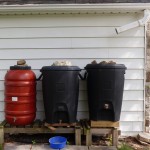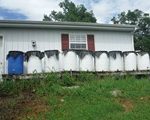by Winding Pathways | Sep 20, 2018 | Chickens, Energy Efficiency, Flowers/Grasses, Garden/Yard, Garden/Yard, Nature
It’s turning time for wildlife, chickens, and people
As the Northern Hemisphere of the earth continues its ageless slow wobble away from the sun, days gradually shorten until a wondrous event happens.
The Autumnal Equinox happens around September 21st each year. It’s when daily hours of sunlight equal those of darkness. On only two days each year does every place on earth enjoy roughly 12 hours of sunshine. These are the fall and spring equinoxes. So, whether someone lives near the tropics or poles they will experience the same amount of light on only those two days.
Light changes quickly around equinox time. Up here in the Northern Hemisphere days shorten quickly and darkness advances until the December 21st Winter Solstice, the year’s darkest day. The Southern Hemisphere begins to enjoy its longest days through December.
Preparing
At Winding Pathways around the Equinox, we do these things:
- Stimulate our chickens. We plug in the timer and light bulb in the coop. Chickens lay the most eggs when there are about 15 hours of daylight. So, the coop light is set up to come on about 4:30 a.m. and turn off about three hours later when the sun pokes over the horizon.
- Drain, clean, and invert our rain barrels. We won’t need extra water until next spring, so we turn the barrels upside down, so they don’t collect winter water that freezes and can split the barrels. We weight them with stones to keep Arctic winds from blowing them away.
- Watch this short video on how to Prepare Rain Barrels
- Bring in pumpkins and winter squash. A frost is soon to come, and we don’t want it to bite our squash. We store

Winter Squash vary in color, texture, shape and size.
pumpkins and squash in a room we rarely use. It stays cool but above freezing. Butternut, Acorn, Hubbard, and most other winter squashes and pumpkins, which actually are a squash, keep for months and give us delicious and vitamin stoked food on cold days.
- Exclude, or try to, insects and mice. Somehow mice, box elder bugs and Asian beetles sense coming cold and find tiny cracks to enter the house and enjoy winter warmed by our furnace and wood stove. Each fall we caulk up cracks and weather strip doors to encourage them to stay outside where we prefer to see them. It’s never perfect. Some always find their way inside.
- Enjoy leaves. Each’s fall’s spectacular leaf color peaks in October but some leaves start turning sooner. Our backyard black walnut starts coloring up in early September. The real show is the deep orange, red, and yellows of our sugar maples. They peak in early to mid-October followed by russet oak leaves.
-

Fall wildflowers are an important food source for insects and birds.
Enjoy wildflowers. Asters, Goldenrods, and Maximilian Sunflowers are the very last blooms of the season. Their colors brighten the yard and provide nectar for insects and then seeds for migrating and overwintering birds. But all this comes with sadness as we know we’ll not see wildflowers again until next spring.
- Watch wildlife. It’s migration time and one of the best seasons for seeing unusual birds. We often look upward and sometimes spot pelicans and waterfowl winging high overhead. By now deer in their subdued winter coats are sleek and well fed on a diet of acorns. Bucks have polished their antlers. Chipmunks and squirrels scurry about caching winter food.
We’d like to hear what you enjoy about the Equinox time. Please email us your joys and projects in this wondrous season.
by Winding Pathways | May 31, 2018 | (Sub)Urban Homesteading, Garden/Yard, Garden/Yard
Problem with Hot Weather
A friend emailed today with this dilemma: “I got a whiff of a horrible smell near my rain barrel. I looked inside, and there’s a horrible, putrid layer of something floating on the top of the water. I think it might have come from all the fuzz from the trees in the past few days. Do you think I should empty the barrel, scrub it out, and start over? I do have that screen over the top, but something obviously got through it and seems to be “growing” on top of the water.”
Answer
YES!
Solution

Keep your rain barrels clean in hot weather with these easy tips.
It’s important to do these three things to keep the water fresh:
1. Clean gutters to keep leaves, catkins, and other stuff from getting into the barrel and clean the screen at the top of the barrel.
2. Use the water. Don’t let it stand in the barrel for too long. If it’s really rainy water moves through the barrels and helps keep it fairly fresh.
3. A couple of times during the summer empty the barrel, take the lid off, and wash it out with tap water.
4. Winding Pathways has cleaned the screens on our rain barrels several times already and after each rainstorm. They tend to plug up most during the first few rainstorms. It might also help to put a very small amount of chlorine bleach in the water. It’s toxic to bacteria and molds that might live in the barrel.
A little practical maintenance will make using rain barrels a pleasure and help your plants.
by Winding Pathways | Aug 26, 2016 | (Sub)Urban Homesteading, Garden/Yard, Nature, Trees/Shrubs

A Guest Column by Jackie and Peter Hull
When we first moved to Virginia fifteen years ago, we had no idea that the entire state was in a drought which had been ongoing for a couple of years. In order to help water the garden we wanted to grow, we decided to construct rain barrels. We had seen the master gardeners of Bedford, VA, demonstrate how to put them together.
To begin we bought four 55-gallon barrels from Southern Flavorings for $10 apiece. The faucets and pool filters added another $15 bringing the total to $25 a barrel as opposed to $75 to $100 a piece fully equipped from a company. When we modified our barrels a few years later no longer using pool filters, we had to add the cost of screening and bungee cords which made a total of $30 a barrel.
In outfitting the barrels Peter cut circular holes in the top of each barrel and fitted them with pool filters to catch debris and give an access to help clean out the barrels in the fall. About five inches from the bottom of the barrels he cut holes just large enough to insert the faucets and rings. To help seal this entrance he used caulking compound. He modified the down spout of the rain gutter to arc over the pool filter to catch the rain. The remaining barrels sat adjacent to the first barrel and each was attached to the other with a short piece of PVC pipe that was inserted from one barrel to the next so the water would flow filling each barrel. The last barrel had an overflow spout at the top pointing to the ground so once it was filled the rain water could dribble to the ground.
As we added more barrels, Peter changed from cutting holes in the top of the barrels to cutting the entire top off and covering with plastic screen and using a bungee cord. Fortunately, the top of each barrel has a lip so the bungee cord fits snugly around the barrel holding the screen securely in place. His thinking was this would make cleaning the barrels much easier. It is. To keep mosquito larvae to a minimum, we put a mosquito donut into each barrel. The screening also protects the birds which was initially my concern when he decided to cut the tops entirely off.
All the barrels sit on benches that we constructed so that the water is gravity fed to the garden through a number of hoses. Over the past several years we’ve added more barrels for a total of eleven rain barrels containing 55 gallons each for a total of 550 gallons of water collected from the metal roofed house and garage. This year we’ve emptied them twice over the growing season as we’ve had alternating rain and warm sunshine.
Winding Pathways Notes: Some people may prefer to buy rain barrels ready to install. Most large home improvement stores sell barrels as do many nature centers. Also, be aware that in some arid areas harvesting rain water is in dispute or illegal unless a person owns the water rights. These laws are changing as times and uses change.
by Winding Pathways | Feb 28, 2016 | (Sub)Urban Homesteading, Chickens, Energy Efficiency, Geology/Weather, Nature
How ironic that many homeowners don’t harvest the rain that falls on their property, yet they buy water to irrigate their lawn and garden. Harvest free water by using rain barrels and rain gardens.
RAIN BARRELS
Since ancient times families have captured rain falling on their roof to use for irrigation. It worked thousands of years ago and still works today. A rain barrel is a large container positioned under a gutter downspout to catch and hold water for later use. They can be homemade but most people prefer buying one. Hundreds of models are on the market and range from simple and inexpensive ones to elaborately designed barrels that are practical and decorative. We purchased ours from Rainwater Solutions and have placed six under the downspouts of two buildings. The free water irrigates our vegetable garden and provides water for our small flock of chickens. For more information see the Winding Pathways blog of April 2015 or check http://www.rainwatersolutions.com/
RAIN GARDENS
Rain gardens are more permanent than barrels. Like the barrels they range from the simple to the elaborate. Rain gardens aren’t used to harvest water for irrigation but channel roof runoff into the ground rather than into storm sewers.
Our rain garden is simple and cost nothing to create. We dug a shallow basin in the lawn about the size of a bath tub where our downspout discharges gutter water. During a light to moderate rain our rain garden absorbs all the roof water and puts it back into the ground where it moistens roots and eventually helps recharge the aquafer. During a fierce thunderstorm it overflows a little but we channel that to the lawn. Between the garden and lawn all the rain falling on our roof stays on our property, benefiting our plants and not creating flooding downhill.
The Indian Creek Nature Center and Linn County Master Gardeners will hold workshops in March 2016 to help participants learn how to make their own rain garden. Other nature centers, master gardener and Extension Offices hold similar workshops in many locations across the country. Books and websites are available to help homeowners plan their rain garden. One of our favorite information sources is the Low Impact Development Center.
Besides harvesting water and reducing downstream flooding there’s another benefit of having a rain garden. Flowering plants that require wet soil flourish in rain gardens but can’t live in nearby dry soil.
by Winding Pathways | May 3, 2015 | (Sub)Urban Homesteading, Energy Efficiency, Preparedness
Many homeowners harvest beans, squash, and tomatoes from their garden. Some collect delicious eggs from a small
backyard flock. Too few harvest one of life’s free necessities – Rain Water!
We set up five rain barrels at Winding Pathways a few years ago. They are so handy we don’t know why we didn’t start harvesting rain years ago. Rain barrels are relatively inexpensive and easy to set up. Water from the barrels irrigates thirsty gardens, provides drinking water for our backyard hens, and is handy for rinsing off dirty hands and tools when working outside. 
Tap water costs money. Rain water is free. It’s delivered by nature without chlorine. Too many homeowners swish rainwater down storm sewers and pay their city for tap water to irrigate.
Rain barrels yield free water but also create social and environmental benefits. They reduce pressure on municipal water systems and wells during droughts and reduce erosion and flooding caused by runoff.
A rain barrel is simply a container that collects and stores water falling on the roof. A faucet positioned low on the barrel makes filling a bucket or attaching a hose easy.
They are hardly a new technology. People have been catching and using rain for thousands of years, especially in arid areas. Relatively new are myriads of lightweight attractive barrels on the market, ranging from plain and simple to highly decorative. Most hold about 50 gallons. Do it “yourselfers” can easily make a rain barrel from a 55 gallon drum and fittings sold in any hardware store.
Most first time rain barrel users are astonished at how much water falls on the roof during even a minor shower. For example 625 gallons of rain falls on a 1000 foot roof during a one inch storm. That would fill nine or ten typical sized barrels, and most houses these days are much larger than 1000 square feet. Even during Iowa’s occasional droughts enough occasional showers fall on our roof at Winding Pathways that we always seem to have water in our five barrels.
What’s Needed to Harvest Rain?
Setting up a rain barrel outside a home that has gutters and downspouts is easy. All that’s needed is the barrel itself, a stand to elevate it, and a way to point the downspout so water goes into the top of the barrel.
The Barrel: Many websites detail how to make a rain barrel from common materials. Simply GOOGLE How to Make a Rain Barrel and several excellent well illustrated instructional sites appear. Manufactured rain barrels can be purchased in big box stores that sell yard and garden equipment. They can also be ordered from numerous places online.
The Stand: A stand gets the barrel up off the ground. Normally a hose fitting is situated near the barrel’s bottom to allow complete draining. We made stands from lumber scrounged from construction site dumpsters. They are about 18 inches tall. Placing the barrel on several cinder blocks is even simpler and requires no carpentry. Remember that a rain barrel holding 50 gallons of water weighs around 400 pounds. Stands must be stout.
The Downspout: Most downspouts extend from the gutter to the ground. Situate the stand and rain barrels below or near a downspout. Common soft aluminum or plastic spouts are easy to cut with a hacksaw. Cut it off above the height of the rain barrel so water falls directly into the top of the barrel. Or, if the barrel needs to be set to the side of the downspout buy a 90 or 45 degree angle elbow from a hardware store and attach it so water reaches the barrel. Be sure to drill a few holes in the joint and secure it with sheet metal screws.
Where to Locate the Barrel. Obviously a rain barrel needs to be located near a downspout, but most houses have several of them. Put the barrel as close as possible to the garden or wherever the water will be used.
Hooking More Than One Together. Most people start with just one rain barrel and then discover that it fills quickly in just a light rain. And, it’s easy to use all the water quickly. The solution is simple. Set up several rain barrels in a way that once the first barrel fills water flows through a small tube into the second, third, and any subsequent ones.
Rain Barrel Maintenance. Barrel maintenance is important but simple. Every five or six weeks we drain our barrels, brush the inside to dislodge the slimy material that forms on the plastic, and wash it out with tap water from a hose. Ice can crack a rain barrel, so in late fall we drain ours, turn them upside down for the winter, and put a rock on top (actually the inverted bottom) to keep the wind from blowing them away.
A Caution. Most roofs are constructed of nontoxic materials, but some may leech toxic chemicals into rainwater. Most cedar shakes have been treated with chemicals so don’t harvest water from such a roof. It’s best to wait three or four months after installing a new asphalt roof before collecting rain.
It’s exciting to bring fresh eggs into the kitchen from a flock of backyard hens, and another satisfying delight of the yard is the delicious beans, chard, and other vegetables that come from the garden. Harvesting free rain after a summer shower is another pleasure offered by a wondrous yard.

COMPANY PROFILE
RAINWATER SOLUTIONS
A few years ago Lynn and Mike Ruck, owners of Rainwater Solutions, helped the Indian Creek Nature Center in Cedar Rapids, Iowa mount a major effort to encourage residents to buy and install barrels they make. Eager residents retrieved barrels they had ordered from the back of a huge semi-truck, and soon nearly 1000 residents began harvesting water.
Many companies make and sell excellent rain barrels. We use ones made by Rainwater Solutions at Winding Pathways, and they’ve served us well. One of their models, called The Moby, holds 65 gallons while its slimmer cousin, The Ivy, holds 50.
Rain Water Solutions rain barrels are made in the USA of 100% recycled content. It is their mission to work with government agencies and non-profits to use rain barrels as an education / outreach tool for water conservation and water quality issues. They also design, consult, and install above and below ground rainwater harvesting systems. For information check their website at www.rainwatersolutions.com.





